- News & information
- About
- History
- George V. Voinovich
- George V. Voinovich Collection
- Calendar
- How to Find Us
- News
- Archives
- Photojournalism Fellowship Project
- Photo Essays
- Current Fellow
- Previous Fellows
- Reports and Publications
- Archives
- Students
- Prospective
- Center for Entrepreneurship
- Environmental Studies
- HTC/Voinovich School Scholars
- Master of Public Administration
- Current
- HTC/Voinovich School Scholars
- Center for Entrepreneurship
- Environmental Studies
- Master of Public Administration
- Alumni
- Contact
- School Leadership
- Strategic Partners Alliance
- Ohio University Public Affairs Advisory Committee
- Ohio University Public Affairs Advisory Committee
- Faculty and Fellows
- Faculty
- Visiting Professors
- Voinovich Fellows
- Professional Staff
| Lawrence M. Witmer,
PhD
|
 |
Nasal air conditioning helped dinosaurs keep a cool head |
|
Common Language Summary 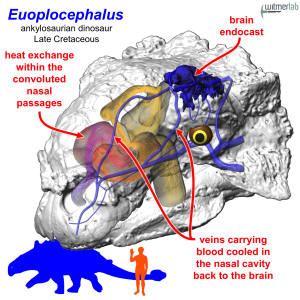
Nasal air conditioners helped armored dinosaurs
keep a cool head.
A decade ago, Ohio University researchers discovered that
armored ankylosaurian dinosaurs had long, convoluted nasal
passages. Now, new research from Ohio University, drawing on
advanced imaging, engineering-based computer modeling, and
anatomy, has shed light on these features, suggesting that these
large-bodied dinosaurs had elaborate “krazy-straw” nasal
passages that functioned as efficient air conditioners to cool
blood that was shunted to the brain cavity to help maintain
brain temperatures within safe limits, helping the animals avoid
heat stress. Large-bodied animals, such as the two
75-million-year-old ankylosaurs— Euoplocephalus
and Panoplosaurus
—that were the focus of the study, face thermal
challenges in that they tend to retain heat and are at risk of
heat stroke, because the hot blood from the body core can damage
the delicate brain tissues. Simulations of nasal airflow
revealed that the dinosaurs’ long tortuous nasal passages
functioned as efficient heat exchangers, warming and humidifying
the air on its way to the lungs. Analysis of CT scans revealed
large canals for blood vessels running next to the nasal
passages that led to the bony brain cavity. As the animals
breathed, evaporation of moisture would have cooled the venous
blood in these canals, providing a mechanism to cool the brain
even as their bodies heated up in the Cretaceous sun. To test if
the long, “krazy-straw” airway was the key to evolving this
efficient air conditioner, the researchers modeled a short and
simple airway (like ours) as well as a long but straight airway
(no twisting). In both cases, the efficiency dropped
dramatically, suggesting that indeed both the length and
convolutions evolved to enhance physiological efficiency. The
researchers are now exploring whether other large-bodied
dinosaurs had similar mechanisms. This research was funded by
grants from the National Science Foundation.
• Download a PDF of the published article:
Bourke, J. M., W. R. Porter, and L. M. Witmer. 2018. Convoluted
nasal passages function as efficient heat exchangers in
ankylosaurs (Dinosauria: Ornithischia: Thyreophora). PLOS ONE
13(12): e0207381 .
•
Download a PDF with key facts about the study, as well as links
to and captions for all the graphics below
Scroll down to read the Ohio University press release

Heat exchange through the highly convoluted nasal passages of the Cretaceous ankylosaurian dinosaur Euoplocephalus not only efficiently warmed and humidified the inspired air on its way to the lungs but also cooled the blood running through the nasal veins, much of which was destined for the brain. In this way, the brain was protected from the high temperatures of the hot arterial blood coming from the body core. Courtesy of WitmerLab at Ohio University. (Silhouettes: Marmelad - CC-BY-SA-2.5)
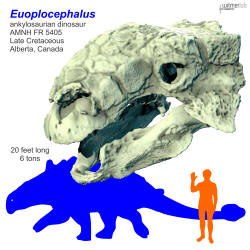 This study of dinosaur thermal physiology focused on the
Cretaceous ankylosaurian dinosaur Euoplocephalus
(illustrated here), as well another less specialized ankylosaur
called Panoplosaurus
. Both dinosaurs were found in Late
Cretaceous fossil deposits of Alberta, Canada. The research team
used CT scanning, soft-tissue reconstruction, and engineering
analyses (computational fluid dynamics) to simulate air and
blood flow and calculate heat exchange in the nasal passages.
Courtesy of WitmerLab at Ohio University. (Silhouettes: Marmelad
- CC-BY-SA-2.5)
This study of dinosaur thermal physiology focused on the
Cretaceous ankylosaurian dinosaur Euoplocephalus
(illustrated here), as well another less specialized ankylosaur
called Panoplosaurus
. Both dinosaurs were found in Late
Cretaceous fossil deposits of Alberta, Canada. The research team
used CT scanning, soft-tissue reconstruction, and engineering
analyses (computational fluid dynamics) to simulate air and
blood flow and calculate heat exchange in the nasal passages.
Courtesy of WitmerLab at Ohio University. (Silhouettes: Marmelad
- CC-BY-SA-2.5)
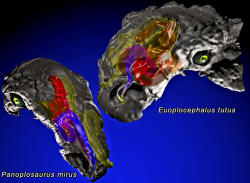
The skulls of the two
ankylosaurian dinosaurs— Panoplosaurus
and Euoplocephalus
—that were the focus of the research. The
skulls are rendered semitransparent, revealing the convoluted
“krazy-straw” nasal passages coiled within their snouts. Colors
within the nasal passages show the heat exchange modeled by the
computational fluid dynamics analysis. The heat exchange allowed
efficient warming and humidification of the inspired air. The
more elaborately coiled nasal passages of Euoplocephalus
were more efficient than the simpler ones of
Panoplosaurus
.
Courtesy of WitmerLab at Ohio University.
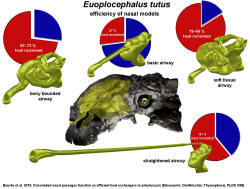
The Late Cretaceous armored dinosaur Euoplocephalus
(center) had a long, highly convoluted nasal passage coiled up
in its snout. The physiological efficiency of heat exchange was
tested by computational fluid dynamics analyses that compared
the (top left) “bony bounded” airway (i.e., as preserved in the
fossil), (top right) the “soft tissue” airway (closer to real
life due to restored nasal mucous membrane), (top middle) the
“basic airway” (short and simple, as in many animals, including
humans), and (bottom) the “straightened airway” (same length as
bony-bounded and soft-tissue airways but without convolutions).
The basic airway is the least efficient, and the long convoluted
soft-tissue air is the most efficient as well as the most
realistic. The long straight airway was also very efficient but
less so than the convoluted airway, indicating that the twists
and turns contribute significantly, probably due to the
increased vorticity that slowed down the airstream and increased
the chance for heat transfer.
Courtesy of WitmerLab at Ohio University.
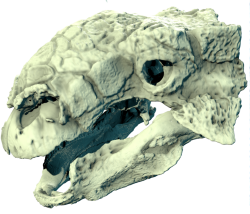
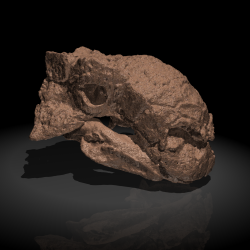
The skull of the Late Cretaceous armored dinosaur Euoplocephalus
that was used in the study.
| This movie is associated with an article published in PLOS ONE on 19 December 2018 ( http://bit.ly/2rzFudE
) by Jason Bourke, Ruger Porter, and Lawrence Witmer. Nasal airflow was modeled using Computational Fluid Dynamics analyses for two Late Cretaceous ankylosaurian dinosaurs, Panoplosaurus and Euoplocephalus. The video demonstrates how the highly convoluted nasal cavity in both species warms the inhaled air on its way to the lung and then cools the exhaled air, resulting in a highly efficient system of air conditioning that conserves both heat and water. For more in this project, visit the WitmerLab project page: http://bit.ly/2EwOzMO
.
• Download a 48 MB QuickTime version (HD: 1920x1080)
|
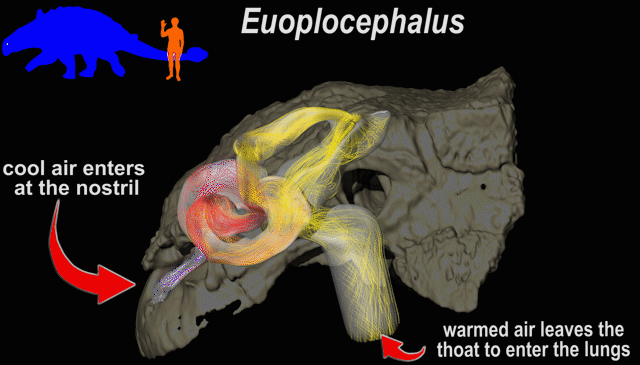 |
| Animated GIF (640x360, 10 MB):
Heat exchange of inspired air as
it passes through the tortuous
nasal cavity of the Late
Cretaceous ankylosaur Euoplocephalus
. The
computational fluid dynamics
analysis shows the flow of air
during inhalation, with color—i.e.,
gray to red to orange to
yellow—indicating progressively
warmer temperatures. Euoplocephalus
has a very
efficient nasal cavity, fully
warming and humidifying the
inspired air before it reaches
the lungs. Panoplosaurus
,
with its simpler nose is
somewhat less efficient but
still impressive. Likewise, on
exhalation, the long convoluted
airways cool the expired air,
saving heat and energy.
Courtesy of WitmerLab at Ohio University.
|
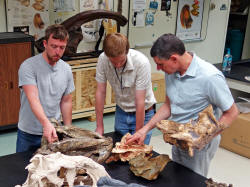
Authors of the article investigate key features in the skulls of ankylosaurian dinosaurs in WitmerLab at Ohio University. From left: Jason Bourke, Ruger Porter, and Lawrence Witmer. Courtesy of WitmerLab at Ohio University. |
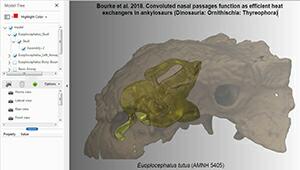
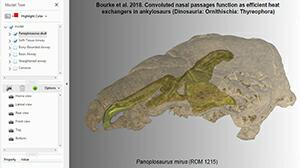
|
| 3D-PDF of the skull and nasal passages of the ankylosaurian dinosaurs Euoplocephalus and Panoplosaurus , showing the four different shapes of the airways tested: “bony bounded” airway (as preserved in the fossil), “soft tissue” airway (closer to real life due to restored nasal mucous membrane), “basic airway” (short and simple, as in many animals, including humans), and “straightened airway” (same length as bony-bounded and soft-tissue airways but without convolutions). 3D-PDF files should be saved and then run on your computer; they will not run in a browser window. Courtesy of WitmerLab at Ohio University. |
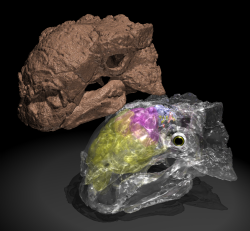
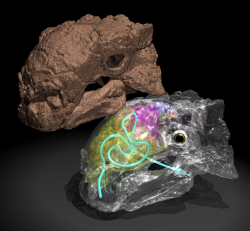
Skulls of the Late Cretaceous armored dinosaur Euoplocephalus represented as a solid skull (left) and as a transparent skull, revealing the long convoluted nasal cavity within the snout. |
EMBARGOED FOR RELEASE WEDNESDAY, 19 DECEMBER 2018, 2 PM EST
Breathing study shows huge armored dinosaurs battled
overheating with nasal air-conditioning
Researchers use 3D computer modeling to simulate heat exchange
in dinosaurs
ATHENS, Ohio (Dec. 19, 2018) – Being a gigantic dinosaur presented some challenges, such as overheating in the Cretaceous sun and frying your brain. Researchers from Ohio University and NYITCOM at Arkansas State show in a new article in PLOS ONE that the heavily armored, club-tailed ankylosaurs had a built-in air conditioner in their snouts.
“The huge bodies that we see in most dinosaurs must have gotten really hot in warm Mesozoic climates,” said Jason Bourke, Assistant Professor at the New York Institute of Technology College of Osteopathic Medicine at Arkansas State and lead author of the study. “Brains don’t like that, so we wanted to see if there were ways to protect the brain from cooking. It turns out the nose may be the key.”
Bourke and the team used CT scanning and a powerful engineering approach called computational fluid dynamics to simulate how air moved through the nasal passages of two different ankylosaur species, the hippo-sized Panoplosaurus and larger rhino-sized Euoplocephalus , to test how well ankylosaur noses transferred heat from the body to the inhaled air.
“A decade ago, my colleague Ryan Ridgely and I published the discovery that ankylosaurs had insanely long nasal passages coiled up in their snouts,” said study co-author Lawrence Witmer, professor at the Ohio University Heritage College of Osteopathic Medicine. “These convoluted airways looked like a kid’s ‘krazy-straw!’ It was completely unexpected and cried out for explanation. I was thrilled when Jason took up the problem as part of his doctoral research in our lab.”
“This project is an excellent example of how advances in CT scanning, 3-D reconstruction, imaging, and computational fluid dynamics modeling can be used in biological research to test long-standing hypotheses,” said Kathy Dickson, a program officer at the National Science Foundation that funded the research. “From these new images and models, fossils can provide further insight into extinct organisms like the ankylosaur – in this case, offering an explanation of how unusual features actually function physiologically.”
Smell may be a primary function of the nose, but noses are also heat exchangers, making sure that air is warmed and humidified before it reaches our delicate lungs. To accomplish this effective air conditioning, birds and mammals, including humans, rely on thin curls of bone and cartilage within their nasal cavities called turbinates, which increase the surface area, allowing for air to come into contact with more of the nasal walls. “Ankylosaurs didn’t have turbinates, but instead made their noses very long and twisty,” said Bourke.
When the researchers compared their findings to data from living animals, they discovered that the dinosaurs’ noses were just as efficient at warming and cooling respired air. “This was a case of nature finding a different solution to the same problem,” said Bourke .
Just how long were these nasal passages? In Panoplosaurus , they were a bit longer than the skull itself and in Euoplocephalus they were almost twice as long as the skull, which is why they’re coiled up in the snout. To see if nasal passage length was the reason for this efficiency, Bourke ran alternative models with shorter, simpler nasal passages that ran directly from the nostril to the throat, as in most other animals. The results clearly showed that nose length was indeed the key to their air-conditioning ability. “When we stuck a short, simple nose in their snouts, heat-transfer rates dropped over 50 percent in both dinosaurs. They were less efficient and didn’t work very well,” said Bourke.
Another line of evidence that these noses were air conditioners that helped cool the brain came from analyses of blood flow.
“When we reconstructed the blood vessels, based on bony grooves and canals, we found a rich blood supply running right next to these convoluted nasal passages,” said Ruger Porter, lecturer at the Ohio University Heritage College of Osteopathic Medicine and one of the study’s co-authors. “Hot blood from the body core would travel through these blood vessels and transfer their heat to the incoming air. Simultaneously, evaporation of moisture in the long nasal passages cooled the venous blood destined for the brain.”
So why the need for such effective heat exchangers? The large bodies of Panoplosaurus and Euoplocephalus were really good at retaining heat, which is good for staying warm, but bad when the animals need to cool off. This heat-shedding problem would have put them at risk of overheating even on cloudy days. In the absence of some protective mechanism, the delicate neural tissue of the brain could be damaged by the hot blood from the body core.
“Sure, their brains were almost comically small,” Bourke said. “But they’re still their brains and needed protection.”
The complicated nasal airways of these dinosaurs were acting as radiators to cool down the brain with a constant flow of cooled venous blood, allowing them to keep a cool head at all times. This natural engineering feat also may have allowed the evolution of the great sizes of so many dinosaurs.
“When we look at the nasal cavity and airway in dinosaurs, we find that the most elaborate noses are found in the large dinosaur species, which suggests that the physiological stresses of large body size may have spurred some of these anatomical novelties to help regulate brain temperatures,” Witmer said.
The next step for the researchers is to examine other dinosaurs to determine when this nasal enlargement happened.
“We know that large dinosaurs had these crazy airways, but at exactly what size did this happen?” Bourke said. “Was this elaboration gradual as body size increased, or is there a threshold size where a run-of-the-mill nose can no longer do the job? We just don’t know yet.”
The research was funded by National Science Foundation (NSF) grants to Witmer (part of the Visible Interactive Dinosaur Project) and an NSF fellowship to Bourke, as well as by the Ohio University Heritage College of Osteopathic Medicine.
-30-
About Ohio University
Ohio University strives to be the best student-centered, transformative learning community in America, where approximately 40,000 students realize their promise, faculty advance knowledge, staff achieve excellence, and alumni become global leaders. OHIO is committed to fostering, embracing, and celebrating diversity in all its forms. Our Athens Campus offers students a residential learning experience in one of the nation’s most picturesque academic settings. Additional campuses and centers serve students across the state, and online programs further advance the University’s commitment to providing educational access and opportunity. Visit www.ohio.edu for more information.
Visit OHIO's official media page for the latest University news and updates, or follow us on Twitter @ohioumedia .
Editors:
• Advance copy can be downloaded here: https://people.ohio.edu/witmerl/Downloads/Bourke_et_al-Ankylosaur_MS_PLOS_ONE_Revisions-3.pdf
• Related images and animations can be downloaded from the
WitmerLab site: https://people.ohio.edu/witmerl/ankylosaur_brain-AC.htm
• A fact sheet can be accessed here: https://people.ohio.edu/witmerl/Downloads/Dinosaur_nasal_air-conditioning_Fact_Sheet.pdf
Contacts (all Eastern Daylight Time):
1. Jason Bourke, 740-818-7503, jbourke@nyit.edu
[lead author]
2. Lawrence Witmer, 740-591-7712, witmerL@ohio.edu
[co-author]
3. Jim Sabin, 740-593-0858, sabin@ohio.edu
[Ohio University Communications and
Marketing]
4.
Kim Tucker ,
516-686-4013, kimberly.tucker@nyit.edu
[NYITCOM External Relations & Marketing]
This project was funded by grants from the National Science Foundation .
| Ohio University Heritage College of Osteopathic Medicine Irvine Hall, Athens, Ohio 45701 740-593-2530 740-597-2778 fax |
Last updated:12/19/2018
Contact Information:
(740) 593–9381 | Building 21, The Ridges
Ohio University Contact Information:
Ohio University | Athens OH 45701 | 740.593.1000 ADA Compliance | © 2018 Ohio University . All rights reserved.
















